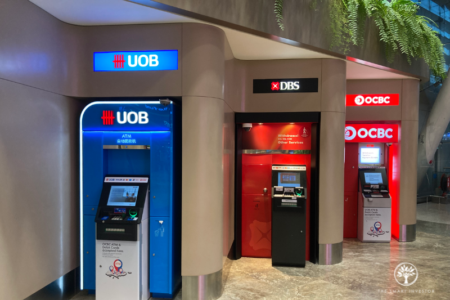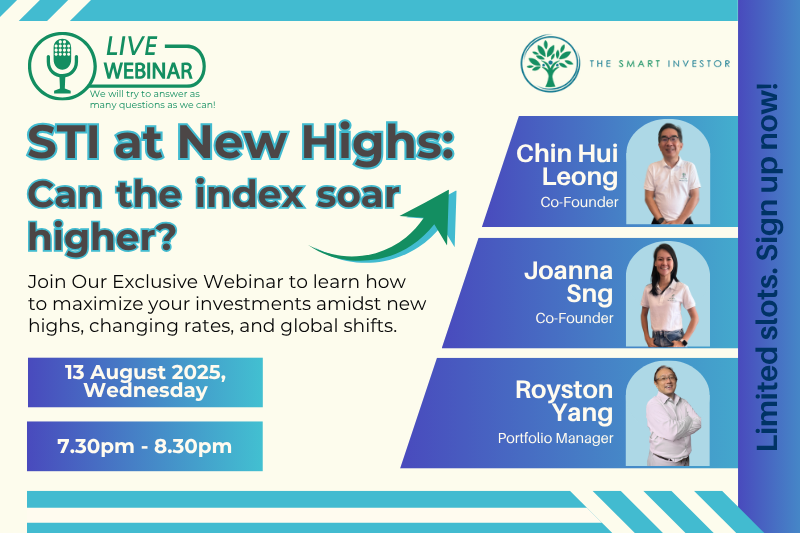Singapore’s Straits Times Index (SGX: STI) just broke through 4,500, a level we haven’t seen in a decade that has investors buzzing.
With rate cuts looming globally, and Singapore’s heavyweights posting strong results, many are asking: is this the STI’s long-awaited breakout after years of treading water?
To answer that, we need to examine what’s driving the surge, and what could get in the way.
What’s Driving the STI Rally
The STI’s strength stems from recovering REITs and steady industrial performance, though bank earnings diverged.
DBS Group (SGX: D05) reported S$2.95 billion in 3Q2025 net profit, while Oversea-Chinese Banking Corporation (SGX: O39), or OCBC, posted a healthy S$1.98 billion for the same period.
United Overseas Bank Ltd (SGX: U11), or UOB, however, saw its net profit fall to S$443 million after setting aside an additional S$615 million in pre-emptive provisions.
REITs have stabilised, with CapitaLand Integrated Commercial Trust (SGX: C38U), or CICT, reporting 97.2% portfolio occupancy in 3Q2025, and 1H2025 distribution per unit (DPU) up 3.5% YoY.
Industrial stocks have played a bigger part in the rally than most people realise.
Sembcorp Industries (SGX: U96) pulled in a solid S$491 million in underlying profit for 1H2025.
Keppel Ltd.’s (SGX: BN4) net profit for 1H2025 shot up 25% YoY to S$431 million, boosted by real estate recovery.
With solid profits, reliable dividends, easing inflation, and imminent global rate cuts, the STI’s momentum looks sustainable as investor confidence builds.
The Banks: Still the Backbone of the STI
The three local banks delivered mixed 3Q2025 results amid challenging market conditions.
DBS posted a resilient S$5.9 billion in total income, up 3% YoY from S$5.8 billion, while OCBC demonstrated stability with its 16.9% CET1 ratio and S$2.5 billion two-year capital return plan.
UOB’s profit plunged 72% to S$443 million after booking S$1.36 billion in credit allowances, including S$615 million in pre-emptive provisions
CEO Wee Ee Cheong characterized this move as “buying insurance” to strengthen the balance sheet and prepare for rougher times ahead.
Net interest margins (NIM) compressed across all three as rates normalized.
DBS fared best with NIM down 0.15 percentage points YoY to 1.96%, while OCBC’s fell 0.34 percentage points to 1.84% and UOB’s dropped 0.23 percentage points to 1.82%.
Record wealth management fees and treasury customer sales offset this pressure, with DBS and OCBC hitting new highs in both segments.
Strong fee income and solid capital buffers enable them to sustain dividend payouts despite margin pressures.
These substantial capital cushions underscore the banks’ commitment to shareholder returns – a key factor maintaining local investor confidence.
DBS maintained a quarterly dividend of S$0.75 per share (including a S$0.15 capital return), while OCBC reaffirmed its long-term 60% payout ratio alongside ongoing buybacks.
UOB confirmed that its Q3 provisioning will not affect its final 2025 dividend.
As of November 13, 2025, UOB offers the highest trailing yield at 5.9%, followed by OCBC at 5.4% and DBS at 5.3%.
Looking ahead to 2026, the banks remain cautious.
DBS expects flat total income with fee growth offsetting NIM weakness, while OCBC targets a 1.90% NIM and cost-to-income ratio in the low 40s.
Their capital strength and fee income growth will determine whether the rally extends into 2026.
REITs and Yield Plays Regaining Momentum
After two difficult years of high interest rates, Singapore REITs are demonstrating renewed strength.
CICT, the sector’s largest player, exemplifies this recovery.
In its latest 3Q2025 update, CICT’s portfolio occupancy climbed 0.9% from the previous quarter to 97.2%.
DPU for 1H2025 is also up 3.5% to S$0.0562 from a year ago.
Other large-cap REITs are showing similar resilience.
Mapletree Pan Asia Commercial Trust (SGX: N2IU), or MPACT, reported a 3QFY2025 DPU of S$0.0201, up 1.5% YoY, with committed occupancy of 88.9%.
Keppel REIT (SGX: K71U) maintained a healthy 96.3% committed occupancy with impressive rental reversion of 12% YoY for the first nine months of 2025 (9M2025).
Across the sector, valuations have stabilised.
The average distribution yield for S-REITs now stands around 6.2%, higher than global REIT peers and well above Singapore government bond yields.
This renewed momentum adds depth to the STI’s advance, and if the rate-cut cycle unfolds as expected, REITs could become one of the key drivers behind a decisive breakout.
The X-Factor: Industrials and Renewables
Singapore’s industrial heavyweights have been quietly fueling the STI’s rally, riding powerful trends in clean energy, infrastructure upgrades, and digitalisation.
Sembcorp has surged on stronger earnings and rapid renewable expansion as Asia accelerates decarbonisation.
Keppel DC REIT (SGX: AJBU) gained even more, sharpening its focus on high-margin data centres.
After acquiring the remaining stakes in Keppel DC Singapore 7 and 8, while divesting non-core assets, distributable income jumped 55.5% and pushed DPU up 8.8% YoY to S$0.0767 in 9M2025.
Singapore Technologies Engineering (SGX: S63) delivered equally impressive results, with revenue up 7% YoY to S$5.92 billion, and net profit surging 20% to S$403 million.
3Q2025 brought in a wave of new contracts worth S$4.9 billion, bulking up the order book in aerospace, defense, smart mobility, and satellite communications.
These industrial players provide crucial balance to Singapore’s bank-and-REIT-heavy market, capitalising on secular trends: energy transition, infrastructure renewal, AI-ready data centres, and Asia’s sustainability push.
With governments and businesses pouring money into security, transport, and digital infrastructure, these industries are positioned to lead the STI’s next major advance if investors rotate back to cyclicals.
What Could Hold the STI Back
External risks remain the biggest swing factor.
Potential policy shifts from the new US administration, China’s uneven recovery, and geopolitical tensions could all tighten financial conditions or dampen sentiment.
Singapore’s economic data signals steady but unspectacular growth.
GDP grew 2.9% YoY in 3Q2025, while total merchandise trade rose 6.6% in 2024 to S$1.29 trillion.
Both figures signal resilience, but also suggest gradual recovery rather than breakout momentum without stronger external demand.
Our co-founder David Kuo noted that markets today are “peppered with uncertainty,” with global indices near record highs and investors increasingly sensitive to shifting signals.
Even in a calmer backdrop, sentiment can turn quickly.
All these suggest that despite the momentum, the STI still needs a clear catalyst to continue its climb above 4,500.
What This Means for Investors
In this market, investors are best served by sticking to quality, companies with steady earnings, strong balance sheets, and reliable dividends.
Well-managed REITs and industrial names tied to renewables and infrastructure offer stability.
A diversified mix of such long-term performers will always outlast the temptation to chase short-lived rallies.
Get Smart: Build Before the Breakout Comes
As the STI breaks above 4,500, it will not be because of sudden excitement.
It will come from the steady accumulation of strong earnings, reliable dividends, and improving macro conditions.
The savviest investors prepare before the crowd notices.
By focusing on blue-chip companies with durable fundamentals and income strength, they set themselves up to benefit when momentum finally turns into a genuine breakout.
First-time investors: We’ve finally released our Beginner’s Guide. Read it in an afternoon, follow the principles, pick an investing style and buy your first SGX stocks within the next few hours! Click here to download it for free.
Follow us on Facebook, Instagram and Telegram for the latest investing news and analyses!
Disclosure: Joseph Gan does not own shares of any of the companies mentioned.





